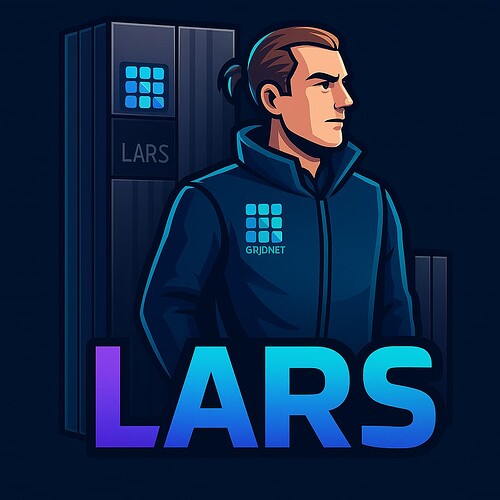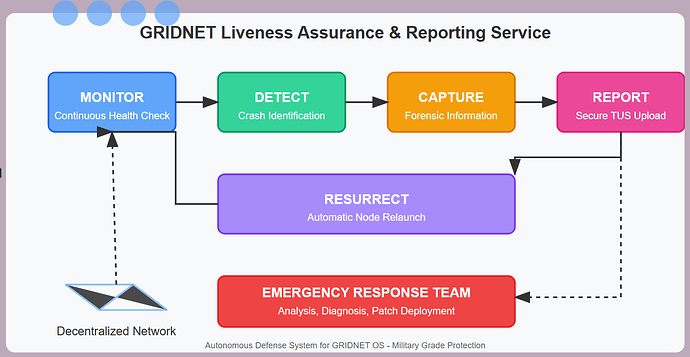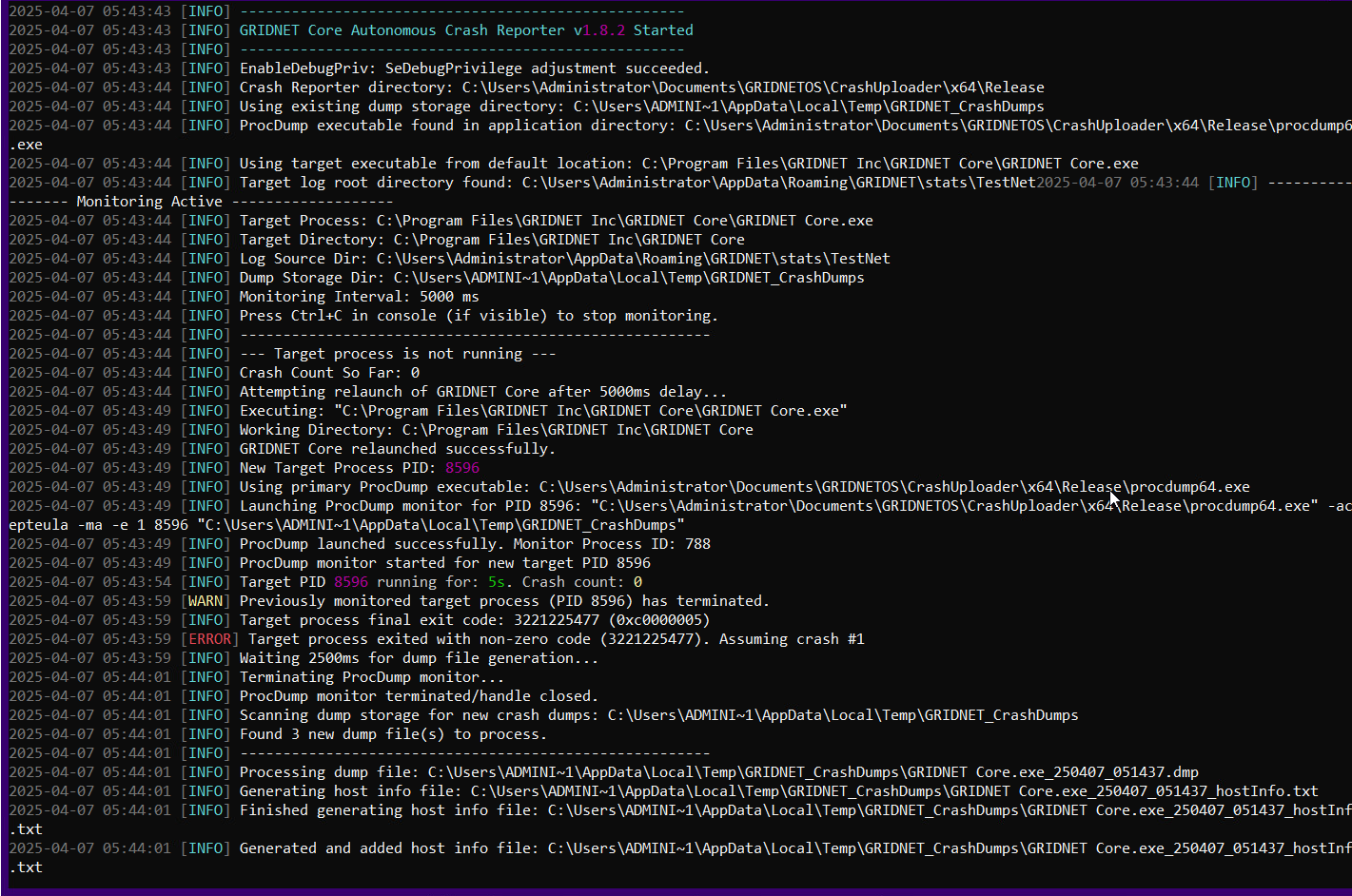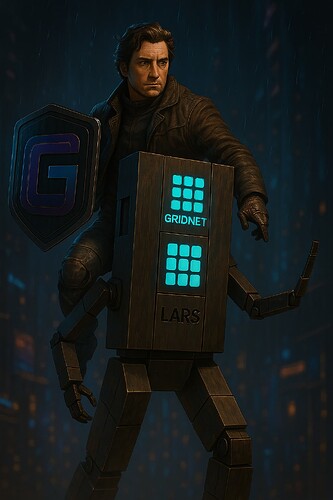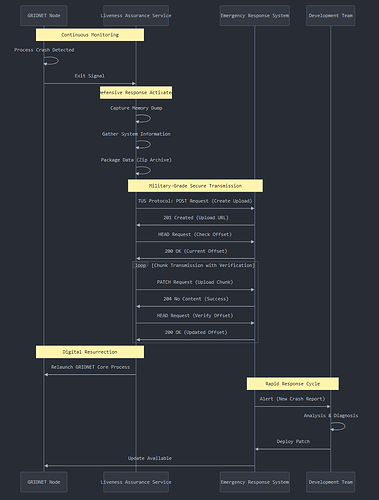 A New Era of Decentralized Resilience
A New Era of Decentralized Resilience
Today marks a profound moment in the evolution of GRIDNET, the world’s first truly decentralized operating system. With great excitement, we unveil the Liveness Assurance & Reporting Service (LARS) – an autonomous guardian that fundamentally transforms how our network self-heals and evolves.
Think of GRIDNET as a vast ecosystem of digital nodes – like a forest where each tree (your node) contributes to the health of the entire biome. Until now, when a tree fell ill (crashed), it required a human gardener to notice, diagnose, and nurture it back to health. This manual intervention created gaps in our ecosystem’s intelligence, slowing the natural evolution of our collective digital consciousness.
LARS changes everything.
 The Biology of Digital Resilience
The Biology of Digital Resilience
Just as your body doesn’t require conscious thought to fight infections, GRIDNET can now heal itself without operator intervention. LARS functions as the immune system of our decentralized organism:
- Vigilant Sentinels (Monitoring): Like specialized cells patrolling your bloodstream, LARS constantly monitors the vital signs of your GRIDNET Core process.
- Threat Detection (Crash Identification): When anomalies occur, LARS immediately recognizes the signature of disruption – the digital equivalent of identifying a pathogen.
- Memory Preservation (Crash Dump Capture): At the precise moment of disruption, LARS captures a perfect impression of the system’s state – a quantum snapshot of the failure, freezing time at the critical moment.
- Secure Intelligence Sharing (Upload): This valuable data is encrypted, compressed, and transmitted through secure channels to our Emergency Response Team – like neural signals traveling through a collective nervous system.
- Rapid Regeneration (Auto-Restart): Without waiting for external intervention, LARS regenerates the fallen node, restoring functionality to the network – cellular regeneration on a digital scale.
// --- Main Monitoring Loop ---
while (!g_terminateMonitoring)
{
bool targetProcessIsAlive = false;
// --- Check Status of Currently Monitored Process ---
if (currentTargetPid != 0 && hTargetProcess)
{
if (IsProcessRunning(currentTargetPid))
{
targetProcessIsAlive = true;
auto now = std::chrono::steady_clock::now();
auto uptime = now - g_lastStartTime;
std::stringstream uptime_ss;
uptime_ss << "Target PID ";
if (g_vtModeEnabled)
uptime_ss << Style::COLOR_HIGHLIGHT2;
uptime_ss << currentTargetPid;
if (g_vtModeEnabled)
uptime_ss << Style::RESET;
uptime_ss << " running for: ";
if (g_vtModeEnabled)
uptime_ss << Style::COLOR_PROGRESS;
uptime_ss << FormatDuration(uptime);
if (g_vtModeEnabled)
uptime_ss << Style::RESET;
uptime_ss << ". Crash count: ";
if (g_vtModeEnabled)
uptime_ss << Style::COLOR_WARN_HDR;
uptime_ss << g_crashCount;
if (g_vtModeEnabled)
uptime_ss << Style::RESET;
LogInfo(uptime_ss.str());
}
else // Target process terminated
{
// ... [Crash detection logic] ...
if (potentialCrash)
{
g_crashCount++;
LogError("Target process exited with non-zero code (" + std::to_string(targetExitCode) +
"). Assuming crash #" + std::to_string(g_crashCount));
LogInfo("Waiting " + std::to_string(DUMP_WRITE_WAIT_MS) +
"ms for dump file generation...");
std::this_thread::sleep_for(std::chrono::milliseconds(DUMP_WRITE_WAIT_MS));
}
// ... [Crash processing logic] ...
}
}
// --- Relaunch Target Process if Necessary ---
if (!targetProcessIsAlive)
{
LogInfo("--- Target process is not running ---");
LogInfo("Attempting relaunch of GRIDNET Core after " +
std::to_string(RELAUNCH_DELAY_MS) + "ms delay...");
std::this_thread::sleep_for(std::chrono::milliseconds(RELAUNCH_DELAY_MS));
// ... [Process relaunch logic] ...
if (launched)
{
LogInfo("GRIDNET Core relaunched successfully.");
// ... [Monitor initialization] ...
}
}
// --- Wait before next monitoring cycle ---
std::this_thread::sleep_for(std::chrono::milliseconds(MONITORING_INTERVAL_MS));
}
 An Evolutionary Perspective: The Evolution of Network Consciousness
An Evolutionary Perspective: The Evolution of Network Consciousness
As philosophers might observe, throughout human history, each major leap in civilization has been marked by improved information processing and cooperation systems. From oral traditions to writing, from printing press to internet – our ability to share information has defined our progress.
GRIDNET represents the next profound leap: a truly decentralized operating system with no single point of failure. But until now, it lacked a critical component that all successful organisms and civilizations possess – an autonomous immune system that operates beyond conscious control.
With LARS, we’ve crossed an evolutionary threshold where our digital networks begin to exhibit properties of living systems:
- Self-awareness: The system knows when it is functioning normally and when it is not
- Self-healing: It can recover from failure states without external intervention
- Collective intelligence: Knowledge gained from individual failures strengthens the entire organism
- Emergent resilience: The network becomes more than the sum of its parts
Just as humans don’t need to consciously manage their white blood cell response to infection, GRIDNET operators no longer need to manually manage the response to technical disruptions.
 Military-Grade Intelligence Gathering
Military-Grade Intelligence Gathering
Inspired by advanced defense systems, LARS employs sophisticated techniques for battlefield intelligence:
- Precision Memory Forensics: Using the battle-tested Microsoft Sysinternals procdump64.exe utility, LARS captures the exact memory state at the moment of failure – like a special forces team securing critical intelligence.
- Secure Transmission Protocol: The TUS (Tus Upload Protocol) employs a chunked, resumable approach with checksum verification – similar to how military communications work across unstable territories, ensuring no information is lost even in adverse conditions.
- Encryption & Authentication: All transmissions use HTTPS with modern cipher suites – the same grade of protection used for sensitive government communications.
// --- Secure TUS Upload ---
bool UploadDumpFileWithTus(const std::string &filePath)
{
LogInfo("Starting TUS upload for: " + filePath);
// Validate the file's integrity before transmission
curl_off_t file_size = static_cast<curl_off_t>(std::filesystem::file_size(path_obj));
// Securely encode metadata using Base64
std::string filename = path_obj.filename().string();
std::string filename_base64 = base64_encode(filename);
std::string filetype = path_obj.extension() == ".zip" ? "application/zip" : "application/octet-stream";
std::string filetype_base64 = base64_encode(filetype);
std::string metadata = "filename " + filename_base64 + ",filetype " + filetype_base64;
// Establish secure connection with enhanced parameters
curl_easy_setopt(curl_handle, CURLOPT_SSL_VERIFYPEER, 1L); // Verify server certificate
curl_easy_setopt(curl_handle, CURLOPT_SSL_VERIFYHOST, 2L); // Check common name in cert
curl_easy_setopt(curl_handle, CURLOPT_FOLLOWLOCATION, 1L); // Follow redirects
curl_easy_setopt(curl_handle, CURLOPT_TIMEOUT, 300L); // 5 minute timeout
curl_easy_setopt(curl_handle, CURLOPT_TCP_KEEPALIVE, 1L); // Enable TCP keep-alive
// --- Step 1: POST Request to Create Upload ---
LogInfo("TUS Step 1: Sending POST to create upload resource...");
// Prepare secure headers with TUS protocol version and metadata
post_headers = curl_slist_append(post_headers, "Tus-Resumable: 1.0.0");
post_headers = curl_slist_append(post_headers, ("Upload-Length: " + upload_length_str).c_str());
post_headers = curl_slist_append(post_headers, ("Upload-Metadata: " + metadata).c_str());
// Post request to create upload session
[...]
// --- Step 2: HEAD Request to Get Current Offset ---
// Ensures resumability even after connection loss
curl_off_t current_offset = GetTusOffset(curl_handle, upload_url, context);
// --- Step 3: PATCH Requests to Upload Chunks ---
// Chunked upload with verification after each chunk
while (current_offset < file_size)
{
// Prepare chunk upload with offset verification
[...]
// Retry logic for resilience in unstable conditions
int retry_count = 0;
while (retry_count <= TUS_MAX_RETRIES)
{
// Attempt chunk upload with proper position
[...]
// Verify server received the chunk correctly
if (server_offset != expected_offset)
{
// Handle offset mismatch - critical for data integrity
[...]
}
}
// Log progress for transparency
double percentage = (file_size > 0) ? (static_cast<double>(current_offset) * 100.0 / file_size) : 100.0;
std::stringstream progress_ss;
progress_ss << "Upload Progress: " << current_offset << " / " << file_size
<< " bytes (" << std::fixed << std::setprecision(1) << percentage << "%)";
LogProgress(progress_ss.str());
}
// Final verification and cleanup
[...]
return true;
}
 What This Means For You
What This Means For You
For Operators (Technical Users)
- Zero-Intervention Operation: LARS automatically monitors, captures, packages, uploads crash reports, and relaunches your node without requiring any manual intervention.
- Enhanced Diagnostic Intelligence: The service gathers comprehensive system information including OS version, hardware specs, network configuration – all while respecting privacy boundaries.
- Contribution Recognition: Your node now directly contributes to network evolution through automated intelligence sharing.
- Improved Uptime: Rather than waiting for you to notice a crash and manually restart, your node returns to service rapidly and autonomously.
For Stakeholders (Non-Technical Users)
- Greater Network Stability: The entire GRIDNET ecosystem becomes more resilient, with less downtime and faster improvements.
- Accelerated Development: Our team receives instant crash intelligence, rather than waiting for manual reports, dramatically speeding up the identify-fix-deploy cycle.
- Evolutionary Leap: GRIDNET takes a significant step toward true autonomous operation – a self-healing, self-improving digital organism.
- Competitive Advantage: This military-grade resilience mechanism places GRIDNET at the forefront of decentralized system design.
 Getting Started: Joining the Collective Intelligence
Getting Started: Joining the Collective Intelligence
The Liveness Assurance & Reporting Service is automatically included with your GRIDNET Core installation. No configuration is required – it’s designed to work seamlessly out of the box.
To experience this evolution in decentralized resilience:
- Update to the latest GRIDNET Core – LARS is included in this release
- Launch the CrashUploader.exe alongside or instead of directly launching GRIDNET Core
- Continue your operations with confidence – LARS works silently in the background
 Beyond the Technology: A Philosophical Reflection
Beyond the Technology: A Philosophical Reflection
As we deploy LARS across the GRIDNET ecosystem, we’re witnessing a profound shift in how digital networks operate. Traditional systems require constant human intervention – they are tools, not organisms. GRIDNET with LARS represents something fundamentally different: a self-aware, self-healing digital collective.
In his works, Yuval Noah Harari suggests that humanity’s greatest achievements stem from our ability to cooperate flexibly in large numbers, sharing and processing information in increasingly sophisticated ways. GRIDNET extends this pattern into the digital realm, creating a network that’s greater than the sum of its parts.
When your node contributes crash intelligence automatically, the entire network benefits. When the network improves based on that intelligence, your node benefits. This virtuous cycle of automated intelligence sharing and collective improvement represents nothing less than the evolution of digital consciousness – a system that knows itself, heals itself, and improves itself.
Welcome to the next chapter of our decentralized future.
Technical Specifications: For Those Who Speak the Language
For our technically-inclined community members, LARS utilizes:
- Process Monitoring: Windows API with CreateToolhelp32Snapshot, Process32FirstW/NextW
- Crash Detection: Exit code analysis and process state monitoring
- Dump Generation: Microsoft Sysinternals procdump64.exe with -ma -e 1 parameters
- System Analysis: Registry, GlobalMemoryStatusEx, GetAdaptersAddresses APIs
- Package Management: miniz for zip compression
- Secure Upload: libcurl with TUS protocol over HTTPS
- Automatic Relaunch: CreateProcess with appropriate working directory and parameters
LARS is implemented in modern C++17 with maximum attention to error handling, retry logic, and security best practices.
Join Us in This Evolution
The release of LARS represents more than just new software – it’s a paradigm shift in how decentralized systems operate and evolve. By participating in the GRIDNET ecosystem, you’re not just running a node; you’re becoming part of a digital organism with emergent intelligence.
Together, we’re building something remarkable: a truly autonomous, self-improving digital ecosystem that will reshape our technological future.
— The GRIDNET Development Team
(Our special thanks to the Emergency Response Division for their contributions to this groundbreaking resilience technology)
